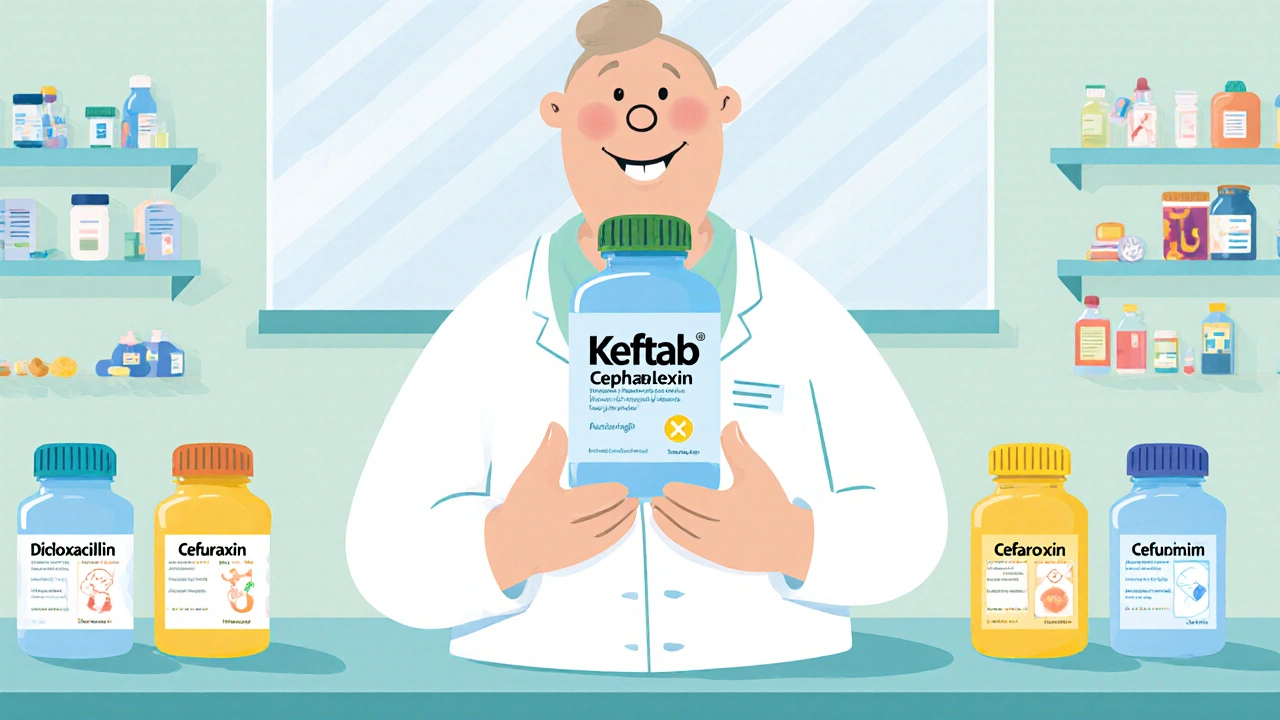Keftab (Cephalexin) vs. Other Antibiotics: Benefits, Side Effects & When to Choose

Antibiotic Selection Tool
Which Antibiotic Is Right For You?
Answer a few questions about your condition to get personalized recommendations based on medical guidelines.
Recommended Antibiotic
Why this antibiotic?
Common Use Cases
When a doctor prescribes an oral antibiotic, the brand name on the label often feels like a mystery. Keftab (Cephalexin) is a widely‑used penicillin‑derived antibiotic, but is it always the best pick? Below we compare Keftab with several common alternatives, breaking down how they work, when they’re most effective, and what trade‑offs you should expect.
What is Keftab (Cephalexin)?
Keftab is the brand name for Cephalexin, a first‑generation cephalosporin that targets a broad range of gram‑positive bacteria and some gram‑negative strains. It’s typically prescribed for skin infections, urinary tract infections, and uncomplicated respiratory infections. The usual adult dose is 250 mg to 1 g every 6‑12 hours, depending on severity.
Common Alternatives to Keftab
While Cephalexin works well for many infections, doctors often consider other options based on the suspected pathogen, patient allergies, and local resistance patterns.
- Amoxicillin is a broad‑spectrum penicillin that covers many of the same organisms as Cephalexin but also hits certain gram‑negative bacteria like H. influenzae.
- Dicloxacillin is a penicillinase‑resistant penicillin used when Staphylococcus aureus is suspected, especially in skin and soft‑tissue infections.
- Cefadroxil is a second‑generation cephalosporin with a slightly broader gram‑negative coverage than Cephalexin.
- Cefuroxime is a second‑generation oral cephalosporin often chosen for sinusitis and bronchitis because it reaches higher lung concentrations.
- Clindamycin is a lincosamide antibiotic that targets anaerobes and certain resistant Staphylococcus strains, useful for bite wounds.
- Penicillin V is the classic narrow‑spectrum penicillin, best for infections caused by susceptible streptococci.
Key Decision Criteria
Choosing the right antibiotic isn’t a one‑size‑fits‑all decision. Below are the most common factors doctors weigh.
- Spectrum of activity - Does the drug cover the likely bacteria?
- Dosage convenience - How many pills per day?
- Side‑effect profile - Risk of GI upset, C. difficile, allergic reactions?
- Allergy considerations - Is the patient allergic to penicillins or cephalosporins?
- Cost & insurance coverage - Brand vs. generic pricing.
- Local resistance data - Are there high rates of resistance to the drug in the area?
Side‑Effect Comparison
All antibiotics can cause adverse reactions, but the frequency and severity differ.
- Cephalexin typically causes mild gastrointestinal upset (nausea, diarrhea) in about 5‑10 % of patients.
- Amoxicillin shares a similar GI profile but has a slightly higher rate of rash in penicillin‑allergic individuals.
- Dicloxacillin can lead to elevated liver enzymes in rare cases.
- Cefadroxil may cause a transient rise in liver enzymes and occasional dizziness.
- Cefuroxime has a slightly higher incidence of taste alteration.
- Clindamycin carries the highest risk of Clostridioides difficile infection, especially with prolonged courses.
Cost Overview (U.S. 2025 average)
Pricing varies by insurance, pharmacy, and whether a brand name or generic is used.
| Antibiotic | Typical Dose | Average Cost (USD) | Generic Available |
|---|---|---|---|
| Keftab (Cephalexin) | 500 mg q6h | $12‑$20 | Yes (Cephalexin) |
| Amoxicillin | 875 mg bid | $8‑$15 | Yes |
| Dicloxacillin | 500 mg q6h | $10‑$18 | Yes |
| Cefadroxil | 500 mg bid | $15‑$25 | Yes |
| Cefuroxime | 250 mg bid | $20‑$35 | Yes (as free acid) |
| Clindamycin | 300 mg q6h | $25‑$40 | Yes |
When to Choose Keftab (Cephalexin) Over Alternatives
If you’re dealing with a straightforward skin infection like impetigo, cellulitis, or a mild urinary tract infection, Cephalexin often wins because:
- It provides excellent coverage against Streptococcus pyogenes and Staphylococcus aureus (non‑MRSA).
- The dosing schedule (twice or three times daily) fits most patients’ routines.
- Side‑effects are generally mild and it’s inexpensive.
However, avoid Cephalexin when:
- The patient has a documented severe penicillin or cephalosporin allergy - cross‑reactivity can be up to 10 %.
- MRSA is suspected; clindamycin or linezolid would be better choices.
- You're treating an infection known for high beta‑lactamase production, such as certain ENT infections; cefuroxime or amoxicillin‑clavulanate may be more reliable.
Practical Tips for Patients
Regardless of which antibiotic you end up with, these habits improve outcomes:
- Take the full prescribed course, even if symptoms improve early. Stopping too soon can select resistant bacteria.
- Space doses evenly - if you miss a dose, take it as soon as you remember unless it’s almost time for the next one.
- Take Cephalexin with food if you experience stomach upset; many patients report better tolerance.
- Stay hydrated; it helps the kidneys clear the drug and reduces the risk of crystalluria.
- Watch for rash, especially if you have a history of drug allergies. Seek medical help if the rash spreads or you develop difficulty breathing.

How Resistance Patterns Influence Choice
Antibiotic resistance evolves quickly. In 2024 the CDC reported a 30 % increase in community‑acquired Staphylococcus aureus resistant to first‑generation cephalosporins in the Southern United States. That means clinicians in Houston or Dallas may prefer Dicloxacillin or Clindamycin for skin infections, whereas physicians in the Pacific Northwest might still feel comfortable with Cephalexin.
Check local antibiograms - many hospital labs publish an annual summary of which organisms are sensitive to which drugs. If you’re getting a prescription from a tele‑health service, ask whether they considered local resistance data.
Summary of Strengths & Weaknesses
Below is a quick reference you can keep on your phone or print out.
- Keftab (Cephalexin) - Strong against common skin & urinary pathogens, cheap, twice‑daily dosing; weak against MRSA, beta‑lactamase producers.
- Amoxicillin - Broader gram‑negative coverage, good for ear & throat infections; limited for Staph, allergy risk.
- Dicloxacillin - Penicillinase‑resistant, ideal for suspected Staph aureus; more frequent dosing.
- Cefadroxil - Slightly broader spectrum, useful for ear infections; higher cost.
- Cefuroxime - Excellent lung penetration, good for sinusitis; twice‑daily dosing, pricier.
- Clindamycin - Covers anaerobes & MRSA, important for bite wounds; highest C. difficile risk.
Frequently Asked Questions
Can I take Keftab if I’m allergic to penicillin?
Cross‑reactivity exists between penicillins and first‑generation cephalosporins like Cephalexin. If you have a severe penicillin allergy (anaphylaxis), avoid Keftab and discuss alternatives with your doctor.
How long does a typical Keftab course last?
For uncomplicated skin infections, doctors usually prescribe 7‑10 days. Some urinary infections may be treated in 5‑7 days.
Is it safe to use Keftab while pregnant?
Cephalexin is classified as Pregnancy Category B, meaning animal studies showed no risk and there are no well‑controlled studies in humans. It’s generally considered safe, but always confirm with your obstetrician.
What should I do if I develop diarrhea while on Keftab?
Mild diarrhea is common and often harmless. Stay hydrated and monitor the symptoms. If stools become watery, contain blood, or you feel feverish, contact your doctor - it could be a sign of C. difficile infection.
Can I switch from Keftab to Amoxicillin halfway through treatment?
Switching antibiotics without a clinical reason is not recommended. Different drugs have different dosing intervals and tissue penetration. Talk to your healthcare provider before making any change.
Choosing the right antibiotic is a balance of science, cost, and personal health factors. By understanding how Keftab (Cephalexin) stacks up against its peers, you can have a more informed conversation with your prescriber and feel confident about the treatment plan.

14 Comments
I alwats keep a list of every antibiotic Ive taken just in case my doctor forgets what works for me
Choosing an antibiotic mirrors a subtle negotiation between microbial resistance patterns and daily routine, the process whispers about broader healthcare economics, each prescription is a personal micro‑decision that ripples through daily life
The pharmacodynamic profile of cephalexin warrants particular attention in the context of beta‑lactamase‑producing organisms.
Its affinity for penicillin‑binding proteins (PBPs) 1A and 1B underpins the bactericidal activity against gram‑positive cocci.
However, the minimum inhibitory concentration (MIC) ceiling against methicillin‑resistant Staphylococcus aureus (MRSA) remains clinically unattainable.
Comparative pharmacokinetic analyses reveal a half‑life of approximately one hour, necessitating multiple daily doses for sustained serum concentrations.
In contrast, amoxicillin‑clavulanate demonstrates extended coverage of beta‑lactamase producers due to the synergistic inhibition of the enzyme.
The cost–benefit calculus must incorporate both direct pharmacy expenditures and indirect costs such as patient adherence.
Dosing convenience, often expressed as q6h versus bid, correlates with compliance metrics observed in outpatient cohorts.
Moreover, the adverse event spectrum of cephalexin is dominated by mild gastrointestinal disturbances, with an incidence rate of roughly 7 %.
In comparison, clindamycin carries a substantially higher propensity for Clostridioides difficile colitis, a factor that heavily influences stewardship protocols.
Local antibiograms, when integrated into the decision algorithm, can shift the preferred agent toward a second‑generation cephalosporin in regions with elevated first‑generation resistance.
Clinicians should also assess patient‑specific variables such as renal function, as dose adjustments are recommended for creatinine clearance below 30 mL/min.
For pregnant patients, cephalexin retains a Category B classification, whereas doxycycline is contraindicated.
Therapeutic drug monitoring is seldom required for oral cephalexin, yet awareness of potential drug–drug interactions, such as with oral contraceptives, remains prudent.
Ultimately, the selection of Keftab versus alternatives epitomizes evidence‑based practice tempered by pragmatic considerations.
By aligning the antimicrobial spectrum with the suspected pathogen, clinicians can minimize collateral damage to the microbiome while preserving therapeutic efficacy.
Great breakdown! 🙌 If you’re ever unsure which drug fits a particular case, a quick look at the local antibiogram can save you from picking an agent that’s already losing its edge. Also, remember that adherence spikes when you can stick to a twice‑daily schedule, so if you can switch from q6h to bid without compromising the PK/PD targets, patients will thank you.
Finally, don’t forget to counsel patients to stay hydrated – it reduces the risk of crystalluria, especially with higher‑dose cephalosporins.
While the author's summary is thorough, it fails to acknowledge that the economic analysis omits the hidden costs of medication non‑adherence, which can offset any nominal price advantage of cephalexin over generics like amoxicillin.
Honestly the cheap price argument ignores the real human cost when people stop treatment early and spread resistant bugs
The piece reads like a textbook summary; a bit more real‑world nuance about prescribing habits would make it more useful.
Hey everyone, just wanted to say that no matter which antibiotic you end up on, finishing the full course is the key to keeping infections from bouncing back – stay healthy!
This article is a game changer for anyone scared of antibiotics.
While the enthusiasm is appreciated the reality is that antibiotics like cephalexin still carry risks that can’t be glossed over with hype.
In the broader lexicon of antimicrobial stewardship, the discourse surrounding first‑generation cephalosporins often suffers from a reductionist portrayal that neglects their nuanced pharmacoeconomic footprint. The author’s dichotomous framing, pitting Keftab against an eclectic array of alternatives, inadvertently perpetuates a binary that fails to capture the spectrum of clinical decision‑making. A more sophisticated analysis would integrate patient‑centered outcomes, resistance trend modeling, and real‑world adherence data, thereby transcending the simplistic cost‑versus‑efficacy narrative currently presented.
One must also consider the covert influence of pharmaceutical lobbying on the apparent prevalence of certain brand names in clinical guidelines; the prominence of Keftab may not be solely a reflection of its pharmacological merit but rather an artifact of strategic market penetration.
Honestly the whole comparison feels like a sales pitch – most of these drugs are interchangeable for a lot of regular infections.
Don’t let that cynicism stop you from learning the real differences – grab the local antibiogram, ask your doctor why they chose a specific drug, and own your treatment plan.